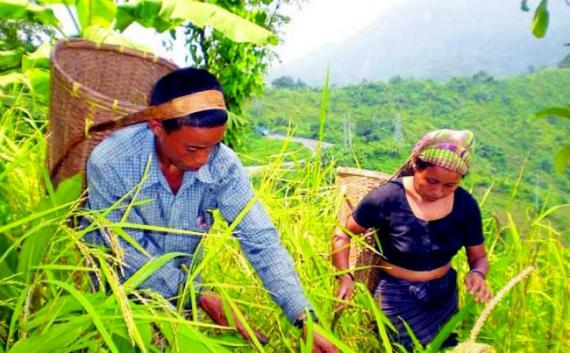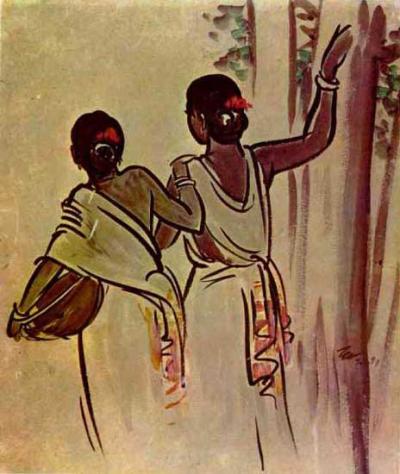চাকমা রাঙামাটি, বান্দরবান ও খাগড়াছড়ি জেলায় বসবাসকারী বাংলাদেশের আদিবাসী সম্প্রদায়। চাকমারামঙ্গোলীয় জাতির একটি শাখা এবং বৌদ্ধ ধর্মের অনুসারী। বৌদ্ধপূর্ণিমা ছাড়া তাদের অন্যতম প্রধান আনন্দ উৎসব হচ্ছে বিজু। তাদের প্রধান জীবিকা কৃষি কাজ। জুম চাষের মাধ্যমে তারা বিভিন্ন খাদ্যশষ্য ও রবিশষ্য উৎপাদন করে থাকে।
চাকমাদের উৎপত্তিকাল, আদি নিবাস ও পার্বত্য চট্টগ্রাম অঞ্চলে তাদের আগমন ও ক্রমবিকাশ সম্পর্কে ষোড়শ শতকের আগের কোনো সুস্পষ্ট ইতিহাস পাওয়া যায়নি। তবে এ পর্যন্ত প্রাপ্ত তথ্য থেকে নিশ্চিত বলা যায়, ষোড়শ শতাব্দীর প্রথমার্ধেও পার্বত্য চট্টগ্রামে চাকমাদের বসবাসের নজির আছে। ১৫৬১ সালে এক ইউরোপীয়দের আঁকা ছবি থেকে বাংলার যে মানচিত্র পাওয়া যায় সেখানেও চাকমাদের অবস্থানের প্রমাণ আছে। অষ্টাদশ শতাব্দীর শুরুতে চাকমা রাজ্যের রাজধানী ছিল তৈন বা আলেখ্যাং ডং। সময়ের পরিক্রমায় চাকমা রাজতন্ত্রে নানা উত্থান-পতন ও বর্মা-মোগলদের সঙ্গে সংঘর্ষের কারণে চাকমাদের আবাসস্থল এবং রাজ্য শঙ্খ নদীর তীরবর্তী হাঙ্গরকুল ও চট্টগ্রামের রাঙ্গুনিয়া হয়ে উত্তর-পূর্বে পার্বত্য চট্টগ্রামের দিকে ব্যাপ্ত হয়।
চাকমাদের ভাষার নামও চাকমা। চাকমাদের নিজস্ব বর্ণমালা রয়েছে। চাকমারা ৪৬টি গোজা ও বিভিন্ন গুথি বা গোষ্ঠীতে বিভক্ত। ১৯৯১ সালের আদমশুমারি অনুযায়ী পার্বত্য চট্টগ্রামে চাকমাদের সংখ্যা ২ লাখ ৩৯ হাজার ৪১৭ জন।তবে বর্তমানে তা তিন লাখ ছাড়িয়ে গেছে বলে ধারণা করা হয়। চাকমারা আদি বৌদ্ধ ধর্মাবলম্বী। তবে তারা বৌদ্ধ হলেও কেউ কেউ আবার প্রকৃতি পূজারীও। চাকমারা জন্মান্তরবাদে বিশ্বাস করে। ক্রমাগত সৎকর্ম সাধনের মাধ্যমে নির্বাণ লাভ করা যায় বলে বিশ্বাস করে তারা।
উৎসব
চাকমাদের সবচেয়ে বড় ধর্মীয় উৎসব বিজু। বাংলা বছরের শেষ দুদিন ও নতুন বছরের প্রথম দিন এ উৎসব পালন করা হয়। বাংলা বছরের প্রথম দিনকে বলা হয় ফুল বিজু এবং শেষ দিনকে বলা হয় চৈত্র সংক্রান্তি বা মূল বিজু। ফুল বিজুর দিন সকাল বেলা চাকমারা ঘর-বাড়ি পরিষ্কার করে ফুল দিয়ে সাজায়, বুড়ো-বুড়িদের গোসল করায়, নতুন কাপড় দেয়। রাতে বসে পরের দিনের পাচন তরকারি রান্নার জন্য সব্জি কাটতে বসে যা কমপক্ষে ৫টি এবং বেশি হলে ৩২ রকম সব্জির মিশেলে রান্না করা হয়। পরের দিন মূল বিজু, এদিন চাকমা তরুণ-তরুণীরা খুব ভোরে উঠে কলা পাতায় করে কিছু ফুল পানিতে ভাসিয়ে দেন। তারপর সবাই বিশেষ করে ছোটোরা নতুন জামা-কাপড় পরে বাড়ি বাড়ি ঘুরতে থাকে। তবে গ্রাম গুলোতে প্রাচীনকালের মতোন করে ঘিলা খারা (খেলা) হয়। পরের দিন নতুন বছর বা গয্যে পয্যে, নতুন বছরের দিন সবাই মন্দিরে যায়, খাবার দান করে, ভালো কাজ করে, বৃদ্ধদের কাছ থেকে আশীষ নেয়।
চাকমা লোকসাহিত্য বেশ সমৃদ্ধশালী। তাদের লোক কাহিনীকে বলা হয় উবগীদ। চাকমাদের তাল্লিক শাস্ত্র বা চিকিৎসা শাস্ত্র অনেক সমৃদ্ধ। আর বয়ন শিল্পে চাকমা রমণীদের সুখ্যাতি জগৎ জুড়ে।
একসময় জুম চাষের ওপর নির্ভরশীল এ জনগোষ্ঠী এখন নিজ প্রচেষ্টা ও রাষ্ট্রীয় পৃষ্ঠপোষকতায় শিক্ষা-দীক্ষায় বেশ এগিয়ে গেছে। বাংলাদেশের সবচেয়ে অগ্রসর আদিবাসী জনগোষ্ঠী হিসেবে তাই সহজেই বিশেষভাবে পরিচিত চাকমারা। পার্বত্য চট্টগ্রাম যে তিনটি সার্কলে বিভক্ত এর অন্যতম চাকমা সার্কল। বর্তমানে (২০১২) চাকমা সার্কলের চিফ বা চাকমা রাজা হিসেবে খ্যাত ব্যারিস্টার দেবাশীষ রায় তত্ত্ববধায়ক সরকারের প্রধান উপদেষ্টার বিশেষ সহকারী হিসেবে দায়িত্ব পালন করছেন।The Chakma, also known as the Daingnet people, is an ethnic group concentrated in the Chittagong Hill Tracts of Bangladesh. The Chakmas are the largest tribe of Bangladesh. Today, the geographic distribution of Chakmas is spread across Bangladesh and parts of northeastern India, western Burma, southwest China and diaspora communities in USA, Canada, UK, France, South Korea, Japan and Australia.
Within the Chittagong Hill Tracts, the Chakma are the largest ethnic group and make up half of the region’s population. The Chakma are divided into 46 clans or Gozas. They have their own language, customs and culture, and profess Theravada Buddhism. The Chakma Royal Family is one of the major Buddhist royal houses of South Asia.
Scholars differ on the origin and history of Chakma. One popular view among the Chakma is that their ancestors once lived in Champoknagar, although opinions differ as to its location. It is also guessed that the Chakma derived their name from Champoknagar. According to oral history the Chakma left Champoknagar for Arakan in Burma where they lived for about 100 years. They had to leave Arakan for Bangladesh in or around sixteenth century, when Bangladesh was governed by Muslim rulers, before the arrival of the British. Even if we do not believe the story of their origin in Champoknagar, we have reason to believe the Chakma lived in Arakan before they migrated to Bangladesh. They were then nomadic shifting cultivators. On their arrival in Bangladesh the Chakma chiefs made a business contract with the Muslim rulers, promising to pay revenue or tax in cotton. In return they were allowed to live in the hill region and engage in trade with the larger society. By the late eighteenth century, British authorities had established themselves in the southeastern districts of Bangladesh. The British formally recognized a definite territory of the Chakma raja (the paramount chief). In 1776, Sherdoulat Khan became the Chakma raja. He fought unsuccessfully against the British. Further fighting between the Chakma and the British took place between 1783 and 1785. In 1787, Raja Janbux Khan, son of Sherdoulat Khan, made a peace treaty with the British government, promising to pay the latter 500 maunds of cotton. The British recognized the office of Chakma raja throughout the rest of their rule. Different Chakma rajas maintained good relations with the authorities of central administration and the Chakma increasingly came in contact with the Bengali people and culture.
Brief History-
In 1546 CE, when the king of Arakan, Meng Beng, was engaged in a battle with the Burmese, the Sak king appeared from the north and attacked Arakan, and occupied the Ramu of Cox’s Bazar, the then territory of the kingdom of Arakan.
Diego de Astor, a Portuguese, drew a map of Bengal, which was published as Descripção do Reino de Bengalla in the book Quarta decada da Asia (Fourth decade of Asia) by João de Barros in 1615 CE. The map shows a place called “Chacomas” on the eastern bank of the Karnaphuli River, suggesting that this is where the Chakmas used to live at that time.
The Arakan king Meng Rajagri (1593–1612 CE) conquered this land, and in a 1607 CE letter to a Portuguese merchant named Philip de Brito Nicote, addressed himself as the highest and most powerful king of Arakan, of Chacomas and of Bengal.[3]
Defeated by the Arakanese, the Chakmas entered the present Chittagong Hill Tracts and made Alekyangdong, present-day Alikadam, their capital. From Alekyangdong they went north and settled in the present-day Rangunia, Raozan, and Fatikchari upazilas of Chittagong District.
In 1666 CE, Shaista Khan, who was then Mughal Governor of Bengal, defeated the Arakanese, conquered Chittagong, and renamed it Islamabad. However, in the early days the Mughal supremacy was confined only to the plain areas of Chittagong, and the Chakmas remained practically unaffected.
After a few years, when a dispute developed between the Mughals and the Chakmas, the Mughals demanded tribute from the Chakmas for trading with Chittagong.In 1713 CE, peace was established, and soon a stable relationship developed between the Chakmas and the Mughals; the latter never demanded complete subjugation from the former.
The Mughals also rewarded the Chakma king Shukdev Roy, who established a new capital in his own name, in an area is still known as Shukbilash.
There are still ruins of the royal palace and other establishments.
Subsequently the capital was shifted to Rajanagar, Ranirhat, Rangunia Upazila, Chittagong.






